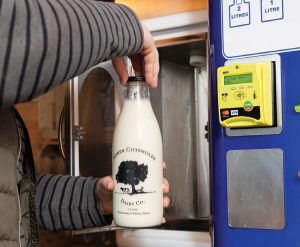
Recent weeks have given the impression of a standstill in the dairy markets, but that’s not the full story.
Prices have moved noticeably, yet confirmation of those moves through traded volumes has remained limited. Butter firmed up and then eased again, SMP corrected downward but now seems to be finding support, and cheese — though under pressure — is softening again after a modest uptick earlier. Zooming out over a four-to-six-week timeframe, price levels appear largely unchanged. This raises a familiar question: are recent market shifts grounded in data and fundamentals, or more in sentiment?
“Sentiment determines the short-term price, fundamentals the long-term.”
We’ve written this line in at least four updates this year, and probably over 20 in recent years. It’s a cornerstone of how we see the market. While it applies across commodity sectors, dairy stands out for its particular sensitivity to sentiment. One reason is the slow pace of data availability. Up-to-date figures on EU milk collections are hard to find — a handful of countries report weekly, but as we write this in May, comprehensive EU data from March is still elusive. The same holds true for production figures per commodity, import/export numbers, and consumption trends.
We’re not immune to this challenge ourselves. Reports of “weaker demand” are often anecdotal — phone calls or emails from individual buyers. Similarly, “strong milk collection” reports may reflect one region or even a single supplier. Much of the market operates on what is essentially hearsay, which is frequently revised, debunked, or at least requires an asterisk. Until we have better alternatives, sentiment will continue to steer short-term price action, while fundamentals will shape the longer arc.
Butter’s 2024 rally: a case in point
In April/May 2024, early signs of tightness in the butter market emerged. Discussions with producers and end users pointed to a looming shortfall, mainly affection prices for the second half of that year. Despite this, buyers we spoke to — whether in emails, on calls, or at trade shows — were skeptical of price levels above €7000, let alone €8000. Producers did have a clearer view on the upcoming shortage, but at the same time, locked in cream sales for the year. In this case, bullish fundamentals were clear, but sentiment lagged — and so did price changes, until momentum finally built in the second half of August.
So why revisit this now?
You might expect us to use this example to lead into a case for why our current bearish market view will soon be validated. In fact, it’s the opposite. Being right on fundamentals is one thing — commodity cycles do repeat, moving from undersupply and high prices to oversupply and lower levels. But timing the transition is increasingly difficult. Whether you’re a buyer, seller, or trader, being correct about the general direction doesn’t guarantee it will play out within your commercial time frame. One of our long-standing partners summed it up last Friday:
“Markets can remain irrational longer than most can stay solvent.”
Our mission is to Inform, Advise and Connect dairy market participants. Perhaps it’s our trading DNA that drives us to predict price movements, but our role as a broker and advisor has taught us that today’s dairy market is shaped by more than just supply and demand. Herd behavior among market participants — buyers, sellers, and traders alike — has intensified over the past decade. Increased transparency via trading and information platforms, brokers, and futures markets is now a bigger factor in short-term pricing than a marginal change in production.
So, will we stop giving you our outlook?
Absolutely not. We love writing these market updates and sharing our views with our growing base of 1000+ readers. But you may notice a subtle shift in tone — a bit more nuance, a bit less absolute conviction. With that said, here’s what we’re watching this week:
GDT: Firmer tone in powders; correction expected in fats and cheese
This week’s GDT could show a slightly more bullish tone, especially for SMP and WMP. Conversations suggest modest gains of 1–2% are likely. We remain cautious on butter — with EU prices recently touching €7300 for July, a correction toward €7200 seems more likely. New Zealand butter could also edge down. Mozzarella, meanwhile, is under pressure, and prices could slip by 3–4%, landing around €4000–4050.
Liquids: Setting the tone
Liquid markets are signaling softness. Trades in sweet cream fell to €7900 and SMC dipped as low as €1450. Raw milk in France remains well under 40ct. The recent run of holidays — Easter, Labour Day — may have skewed the data, but even with last week’s 28°C weather across parts of Europe, demand from the fresh dairy sector was lower than expected. If this trend persists, weaker SMC and cream prices could pressure the butter and SMP markets. We’re watching this closely.
Butter: Slipping back toward €7000
Butter prices have retraced to levels last seen 4–6 weeks ago. Irish butter is near €7000, Polish butter trades at a slight premium (though some trades occurred below €7000), and NL/DE/BE sits between €7150–€7200. Buyers are targeting lower levels, but a lack of volume from producers is keeping prices steady. Should cream fall below €7000 again, we might see more spot offers and further price pressure. That said, cream has surprised before, and we’re cautious about betting on sustained softness.
Indicative starting offers:
- Solarec: 2 trucks @ €7275 for May (bid: €7200)
- Polish: 4 trucks @ €7100 for May (bid: €7000)
- Irish: 4 trucks for June @ €7100 (bid: €7050 for May)
- NL/DE/BE: 4 trucks @ €7180 for May (bid: €7050)
- NL/DE/BE: 6 trucks @ €7225 for Q3 (bid: €7150)
Cheese: Demand fading
The message from the cheese market is consistent: demand is weak. News headlines back this up — McDonald’s reported a 3% drop in US sales, and others confirm similar trends. Softer consumer spending appears to be a factor. Again, this is one of those “hearsay” signals the market relies on. We’ve already flagged declining exports and lower foodservice demand, and now the first data points are beginning to support this.
EU producers appear to be responding. German Gouda offers are around €4250 FCA, and mozzarella has fallen to €4050. However, when asking producers for Q3 quotes at similar levels, most decline — hinting at concerns around milk availability post-June.
Expected Q3 buying interest:
- Mozzarella: 6 trucks @ €4050
- Gouda: 6 trucks @ €4200
Powders: ONIL gives prices a lift
ONIL’s recent tender is giving SMP prices a nudge. Though results are still pending, reports suggest most volume was sourced in the EU around $2950 CIF — higher than expected. This could lend support to EU SMP prices, though domestic demand remains muted. We continue to see bids in the €2300–2350 range and offers around €2400–2450.
We expect a quiet start to the week as buyers assess the ONIL results and await GDT. With our view that GDT may turn slightly firmer, the EU powder market looks likely to stay steady to slightly supported in the days ahead.
Markets don’t wait for certainty. While fundamentals guide us, it’s the day-to-day swings in sentiment, perception, and positioning that often dictate the pace. In times like these, adaptability matters more than conviction. Keep your strategy sharp, stay informed — and don’t confuse being early with being wrong.
You can now read the most important #news on #eDairyNews #Whatsapp channels!!!
🇺🇸 eDairy News INGLÊS: https://whatsapp.com/channel/0029VaKsjzGDTkJyIN6hcP1K




















